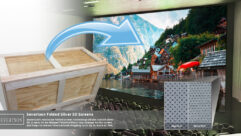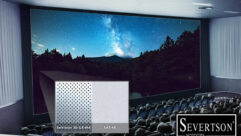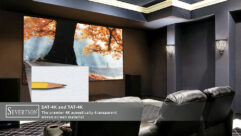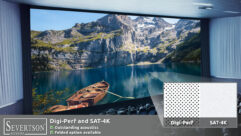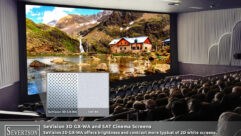Video Projection Screens
Mar 1, 2003 12:00 PM,
Chris Steinwand
On the surface, projection screens don’t seem very complicated, but it’s the actual surface of the screens themselves that is complicated. Technically speaking, for every possible environment and application, there is a different screen type or coating. Knowing how to determine which screen type/surface to use is critical to every installation. In this “Technology Showcase,” I’ll cover the four basic steps to choosing the right screen, and I’ll talk a little about the companies and their offerings.
There are a wide variety of screen types, each with a variety of surface textures that have different characteristics. Selecting the right combination to meet your needs is important for optimum results.
The following offer guidelines for selection. Although these recommendations will work in most situations, each must be looked at not as a strict rule but, rather, as a guideline for determining your actual needs based on your own situation.
SELECTING THE RIGHT SCREEN
Type of screen
Front-projection screens are available in portable, wall-, or ceilingmounted models in either manual or electric versions. The same options are available for rear-projection screens. Generally speaking, if your projection application is permanent, then wall and ceiling screens are your best choice.
Determine the optimal size
There are many factors that will affect this choice, such as room dimensions, planned audience seating size, or capacity and arrangement. Whenever possible, you should fit the screen to the audience — not to the projector. Here are some rules of thumb to assist you in determining screen size: screen height should be no less than one-sixth the distance from the screen to the last row of seats. That will ensure that people at the farthest position from the screen will be able to read text and see the finer details of the video.
Ideally, the first row of seats should be approximately two screen heights away so that people closest to the screen will be able to see the whole picture.
The bottom of the screen should be a minimum of 4 feet above the audience floor, allowing those seated toward the rear of the audience to see the screen. This may require additional screen “drop” for ceiling-hung screens.
Format
This refers to the aspect ratio you need for a given format, depending on the intended program and source projector. See the table “Common Formats and Their Aspect Ratios.”
Screen surface
When selecting a screen surface, there are several factors to consider. The gain of a screen is a relative measure of the screen’s reflectivity. The reference is typically based on the measurement of the percentage of light reflected when shined on a surface of pure magnesium carbonate, as a reference material. A gain of 1 represents 100 percent reflection of light, or undiminished reflection. Though it is possible to have a gain of more than 1 from a particular viewing angle, the laws of physics still apply and the sum of all the parts cannot equal more than the whole. A brighter image as seen from direct viewing will necessarily be balanced by diminished brightness at an off-axis angle.
The other relevant parameter regarding the screen’s surface is the intended viewing angle. In most cases, as the viewing angle increases, the luminosity, or reflectivity of light decreases, but this property is drastically influenced by the screen material. However, the net result is that the total reflected light cannot exceed projected light. It is the characteristics of the screen, or response curve, that is significant. Most of the companies mentioned in this article provide these graphs on their Web sites.
Selection of the most appropriate screen material for your application depends on other application-specific variables, such the as level of ambient light and environmental conditions (indoor/outdoor?). In order to help you make the best decision, I’ll describe some of the more common screen types and their characteristics; however, in many applications, a projection screen is used for more than one purpose, so compromises and balancing trade-offs may be necessary.
Consider these key factors when choosing a front-projection screen surface:
- gain (a relative measure of a screen’s reflectivity);
- contrast (the ability to accurately reproduce and differentiate light and dark characters and backgrounds or light and dark areas of an image);
- ambient light rejection properties (the ability to perform well under normal to adverse lighting conditions in the audience area);
- resolution (the clarity of the projected image);
- uniformity (the screen’s performance when viewed from various points off the projection axis — both horizontally and vertically — and when the brightness of the center of the image is compared to the corners);
- and projection format (the height and width of the projected image determines the screen’s size and shape — AV, NTSC, HDTV, wide screen, Cinemascope, overhead, slide, or motion pictures).
FRONT-PROJECTION SCREEN SURFACES
Here are some of the most common surface options for front-projection screens:
Matte white
This is one of the most versatile screen surfaces and the most common choice for situations where ambient light is controllable. It has a gain of approximately 1 that is fairly linear out to about a 50-degree viewing angle. Colors remain bright and lifelike, with no shifts in hue. This surface is the reference standard.
High-contrast matte white
Typically used with moderate output DLP and LCD projectors, this screen surface is a good choice when video images are the main source of information being projected and where ambient light is moderately controlled. With its specially designed gray base material and reflective top surface, this screen material is able to provide good black levels without sacrificing the white level output. It has about the same linear reflectivity (or gain) as a regular matte white surface but only out to about a 45-degree viewing angle.
Pearlescent
This screen surface is especially designed for demanding video and overhead LCD-panel projection applications in which a balance of higher gain is required. The center gain is about 2.5, but the viewing angle drops to around 35 degrees. This surface is a good choice when producing video images with a lower-output projector and where there is a high amount of ambient light present.
Glass beaded
A glass beaded screen surface has the ability to achieve a higher gain by reflecting more of the projected light back along the projection axis. Glass beads impregnated in the screen’s surface offer additional internal reflectance, providing an unparalleled screen surface for vibrant, lifelike color reproduction at moderate viewing angles, producing a gain of up to 2.5 but with a narrower viewing area of 30 degrees. A glass-beaded surface is a bit more delicate than others and is not recommended for use in applications in which it is likely to be handled frequently or exposed to the elements.
Silver matte
This is a specialty surface, designed for situations where a silver surface is necessary for a polarized 3-D projection. The matte finish of this surface tends to reject ambient light. The trade-off is a gain of around 1.1 and a limited viewing angle of about 30 degrees.
SCREEN BORDERS AND DROP
Black masking borders are standard on many front-projection screens and can be added or modified to suit your application. There are two main reasons for using a black border around your screen surface. First, borders enhance the perceived brightness of an image on a screen. The human eye perceives the image to have more contrast and a sharper picture with brighter colors. Second, borders allow the projected image to “bleed off” the screen, giving a more professional appearance.
Drop is another important accessory commonly used on most wall, ceiling, and electric screens. Drop is extra fabric added to the top or bottom of the screen to adjust the screen surface to within the desired viewing heights. Drop can be specified in black or white.
REAR-PROJECTION SCREEN SURFACES
The fundamental difference between front- and rear-projection screens is that the front-projection screen reflects as much of the light shined on its surface as possible, whereas a rear-projection screen allows light to pass through its surface while reflecting as little light as possible in either direction. There is no reference standard for rear projection as there is in front projection with the matte white surface, so a little more research is required to determine the best surface type for your application. The following information will give you a good understanding of the basic elements and principles involved to aid you in making the right selection.
The most common method of reflecting light through a rear-projection screen is by applying a Fresnel lens surface to the back of the screen. The Fresnel lens was invented by Augustine Fresnel (pronounced fray-nell but most often mispronounced as frez-nel) in France in 1822. The lens is basically a prism with thousands of reflective surfaces that serve to focus and redirect the projected image. This lens was first used in lighthouse towers to increase the strength of the light shining out to sea. In the video projection application, the Fresnel lens technology consists of thousands of horizontal grooves, or angles, usually with a dot pitch of around 0.5 mm. This surface amplifies the light source (video) by redirecting the light rays and transmits the image forward through the actual screen material.
Transmission should not be confused with gain. Gain is controlled by the diffusion and governs the degree to which light from the projector is scattered. Transmission is reduced by the quantity of darkening pigment in the screen material and governs the total amount of light that gets through the screen. Obviously, the balance between diffusion and pigmentation is a delicate one, which is why such a wide selection of diffusions screens is available.
In addition to diffusion coatings, there are also “profiled” screens that are composed of lenticulations (geometric embossed patterns) or Fresnels. Lenticulations have no particular influence on uniformity of light distribution as Fresnels do. Although they are lenses, their only function is to scatter light about its angle of incidence. The difference, of course, is that lenticulations restrict their dispersion to the horizontal axis only. That results in excellent horizontal viewing angles but does not result in reducing brightness discrepancies between an image’s center and its corners. The Fresnel lens is the only screen element that can improve uniformity.
Of the billions of light rays that come out of a projector at any instant, you can illustrate the function of a Fresnel lens by examining the path of just three rays. First, there is the on-axis ray, the one that is going to pass exactly through the middle of a screen. Then there are the outermost light rays on the left and right.
The angular direction of left and right rays are aimed far away from the direction of the on-axis ray. Therefore, as you sit in front of this projection beam, it will be particularly difficult to detect much brightness at all from these rays because they are not aimed anywhere near your eyes. The angles through which those outer rays would have to be bent in order to reach your eyes are called bend angles.
A Fresnel lens reduces these bend angles so that each light ray emitted by the projector is bent back just enough to be parallel with the on-axis ray. At the center of the projection beam, the Fresnel is not doing much work. But by the time you move out to the edges of the beam, the Fresnel is bending the rays through ever larger angles until you get right out to the “edge” rays where the bend angle is maximum. Notice that a Fresnel has its greatest effect at the very places you need it most: at the extremities of the image.
The original purpose of a Fresnel lens was to increase screen gain. Although it still does that, it’s no longer the major consideration, because higher-brightness projectors are now available. The real value in a Fresnel lens today is its ability to make the corners and edges of an image less dim, which significantly reduces the brightness falloff from the center and thereby serves to increase overall uniformity. The process by which divergent light rays from the projector are bent so that they are all parallel is called collimation. No other rear screen property is more important to the critical question of image uniformity.
SOLID SCREEN OR PERFORATED?
All of these screen types, both front and rear projection, can be perforated to allow sound to pass through them. In movie-theater applications, it is common to have the majority of sound reinforcement coming from behind the screen. In smaller surround-sound applications and in some rear-projection applications, it is also common to locate the center-channel loudspeaker behind the screen. Many of the manufacturers mentioned in this article already have “acoustically transparent” versions of their screens available, and some of them offer custom perforating to suit your needs. Bear in mind that acoustically transparent is a vaguely defined term. Any solid matter placed in front of a loudspeaker will attenuate the signal to some degree, at certain frequencies more than others. It’s important to find out what the attenuation level is for the screen you are using so that your audio system can be balanced accordingly, although these specifications are sometimes difficult to come by. Note also that any less screen material will affect reflectivity to some degree; that is why some cinemas prefer solid (nonperforated) screens, placing speakers outside the screen perimeter.
The selection of the most appropriate projection screen requires that you know many (if not all) details about the installation or application beforehand. Visit the Web sites of the manufacturers who produce video projection screens; you’ll find much useful information that goes beyond the scope of what is provided here. Just as is the case with sound systems, consider the whole system in your decision making — remember that the room, the projector, the program material, and your customer’s preferences and budget all play a role in these important decisions.
Screen Size Conversion Charts
Use the following charts to convert an existing NTSC video format screen size to either an HDTV or a letterbox format size.
A Screen With a View-Through: Transparent Screens
One of the most unusual and futuristic types of video screens are transparent screens — so-called holo-screens because they appear to produce holographic images. If you saw the Steven Spielberg film Minority Report, you saw Tom Cruise directing and selecting his precrime images on them. Certain attractions at the Disney theme parks also use this type of screen. They can be used in either front- or rear-projection applications, using special coatings to diffuse and reflect light from the video source. Glass or Plexiglas screens can be mounted, hung, or freestanding and are becoming a common sight at trade shows and in retail displays. Some manufacturers even offer a transparent screen material that can be applied to an existing glass surface, such as a storefront window.
One such manufacturer is the German company G+B pronova GmbH, which makes the HoloPro Holographic projection screen, which is a transparent projection surface for rear projection that can be used in any environment, regardless of ambient light conditions. In the absence of a projected image, the HoloPro appears to be just a pane of clear glass. The projection is directed onto the screen from a specially calculated angle and directed toward the observer by “holographic optical” elements. The company also offers the HoloPro Holographic Mirror screen, which allows front projection. Both are available in screens in sizes up to 67 inches diagonal.
How to Calculate a Custom Screen Size
Use the following formulas to calculate a custom size. The formulas will assist you in finding the viewing area only.
For More Information
Bretford
www.bretford.com
Ž Ž227
Da-Lite Screen Company
www.da-lite.com
Ž 228
Draper
www.draperinc.com
Ž 229
G+B pronova GmbH
www.holopro.com
Ž 230
Harkness Hall
www.harknesshall.com
Ž 231
Hurley
www.hurleyscreen.com
Ž 232
The Screen Works
www.thescreenworks.com
Ž 233
Stewart Filmscreen Corp.
www.stewartfilm.com
Ž 234
Visual Structures
www.vsitrooper.com
Ž 235
Ž Circle this number on Reader Service Card or visit freeproductinfo.net/svc


